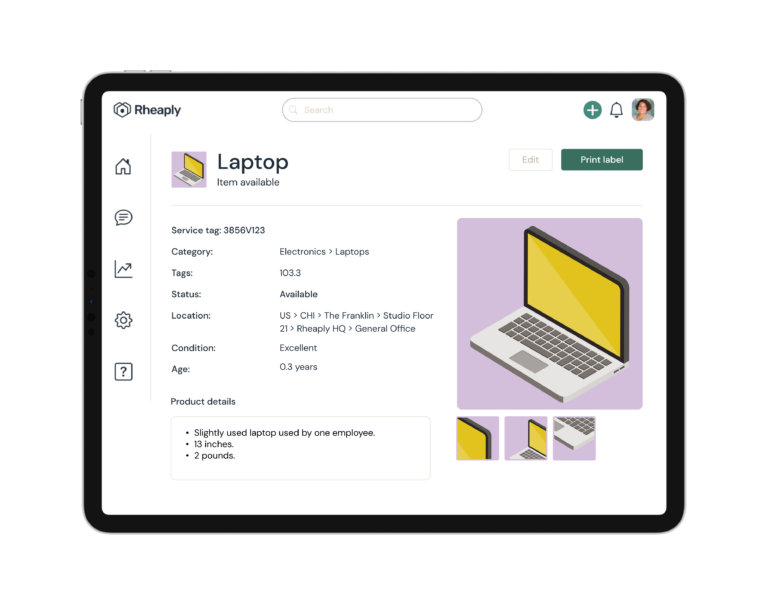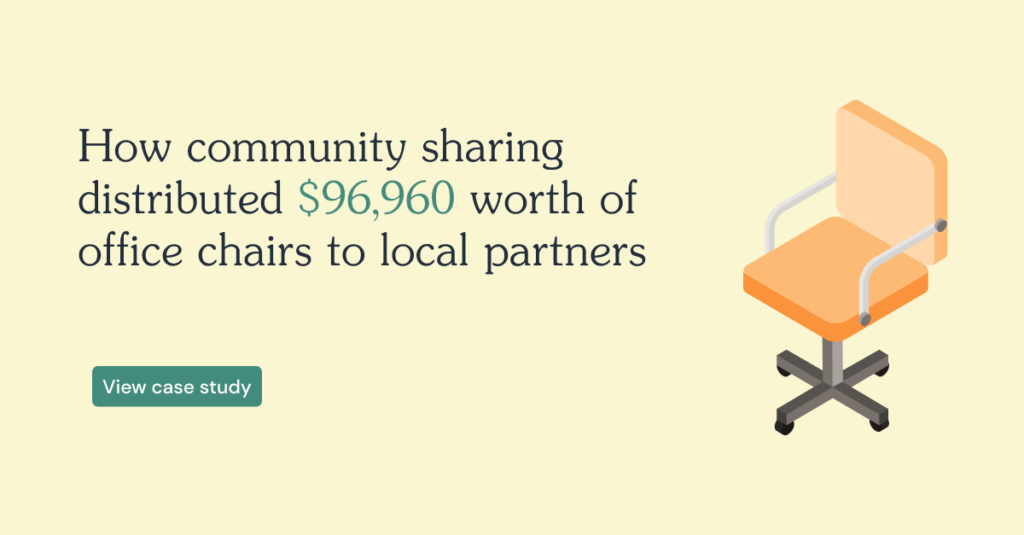Furniture Inventory Management Software
Rheaply puts reuse on the table for every organization.
Furniture Inventory Management Software
In recent years there has been an unprecedented surge in demand for furniture inventory management software as corporations strive to better optimize workspace efficiency and resource utilization. The need to manage thousands of individual furniture items, such as desks and chairs, has propelled businesses to seek scalable and intelligent solutions that can streamline the entire process. These solutions aid in the efficient allocation of resources.
Furniture inventory management software enables organizations to manage furniture items more effectively, ensuring that they are used in the most efficient manner possible. The benefits of implementing such software are multifaceted, ranging from cost savings to improved productivity and employee satisfaction.
For example, using this type of software, organizations can enjoy significant cost savings by maintaining an accurate inventory of all furniture items. It can help them avoid purchasing unnecessary assets and reduce expenditure on maintenance and repairs. This software also allows for the identification of underutilized assets, which can be reallocated or disposed of to further optimize resource usage.
Another key benefit of furniture inventory management software is that it encourages employee productivity and satisfaction. It helps keep workspaces optimally designed and furnished so that employees can work in a comfortable and efficient environment. This can result in greater motivation and output. Because this software can identify surplus or deficit furniture items and facilitate swift adjustments, it enables organizations to quickly adapt to changing needs.
A resource exchange can likewise be a valuable solution for companies that experience frequent changes in their furniture requirements. Exchange programs are often supported through asset inventory management software, making it easy for buyers and sellers to connect. For example, if a company needs to downsize, they can sell surplus furniture items to other businesses that require them, thereby reducing waste and generating revenue.
Physical Resources in Business
Physical resources in business, particularly furniture, play a vital role in organizational success. Efficient physical resources management ensures that assets are properly utilized and contribute to the company’s overall profitability. The importance of physical resources in business is further highlighted when considering the circular economy model, which seeks to minimize waste and make the most of available resources.
Effective physical resources management involves multiple processes and components, including the procurement, maintenance, and disposal of furniture assets. It’s important for businesses to actively manage these resources in order to see to it that they are used in the most efficient manner possible, thereby reducing costs and waste.
So how does effective resource management help with cost efficiency? Organizations that maintain an accurate inventory of all assets can avoid purchasing unnecessary items and reduce expenditure on maintenance and repairs. They can more easily identify underutilized assets that should be reallocated or disposed of. This can result in major cost savings.
By embracing the circular economy, businesses can shift from a linear “take-make-waste” approach to a more sustainable one that aims to extend the life of resources. Instead of simply taking furniture to the dump, organizations can reduce waste by giving their assets new life in a new home.
One way that businesses can incorporate this circular economy model into their physical resources management strategies is by participating in a resource exchange. This involves buying and selling furniture items with other businesses. If a company is expanding, they can purchase used furniture items from other organizations, reducing their capital expenditure and promoting sustainability.
Similarly, if an organization is looking to downsize and get rid of a few things, they can repurpose their old assets via an exchange platform. In doing so, they can recapture some of the original costs of purchase while minimizing their carbon footprint.
Circular Economy for Furniture
With a growing emphasis on the circular economy, businesses today have more options than ever before when it comes to disposing of assets. By implementing circular economy principles, organizations can reap numerous benefits, such as cost savings, improved resource efficiency, and greater sustainability. Furniture inventory management software can be extremely useful when incorporating circular economy practices.
Here are some of the ways that circular economy furniture software can help companies achieve their sustainability goals:
- Efficient Resource Tracking and Optimization: Furniture software allows businesses to accurately monitor their furniture assets. Users can identify underutilized assets and dispose of those items in an environmentally-friendly way. This process promotes the circular economy benefits of resource efficiency and waste minimization.
- Extension of Furniture Lifespan: Software promotes key circular economy practices like recycling. By encouraging businesses to extend the life of their resources, valuable materials are prevented from ending up in landfills, contributing to a greener future.
- Reduction of Environmental Footprint: Another advantage of using furniture inventory management software is that it can identify opportunities for sustainable disposal. Today, there are a number of ways that businesses can get rid of old or underutilized items while maintaining a minimal carbon footprint, and inventory management software helps to point them in the right direction.
- Improved Decision-Making: Furniture inventory management software provides businesses with the necessary data and insights to make informed decisions about when to replace, repair, or dispose of furniture items. It encourages them to consider environmental factors in their decision-making processes to achieve long-term sustainability and resource efficiency.
Organizations that prioritize circular economy and sustainability practices have a leg up on those that do not, both in terms of profitability and reputation. Rheaply’s platform for reuse at scale facilitates this type of circular model. With Rheaply, businesses can manage their office furniture in an eco-friendly manner. Whether they’re looking to dispose of items or source new materials, the platform can be a valuable tool in promoting sustainability.
Office Furniture Decommissioning
Office furniture decommissioning is the process of removing unwanted or outdated furniture from a workplace to create a more functional environment. This practice is essential for businesses that are relocating, downsizing, or even just updating their office space. Proper office furniture disposal minimizes the impact on the environment and ensures that valuable resources are not wasted. The basic steps involved in office furniture disposal are as follows:
- Assessment and Inventory: First, businesses should conduct a thorough assessment of their existing furniture assets. To do this, they might create an inventory of all items, including their type condition. This data is useful for determining which pieces of furniture are still functional and can be reused or repurposed, and which ones should be disposed of.
- Make a Decommissioning Plan: Next, companies should develop a comprehensive decommissioning plan outlining each aspect of the disposal process. It should account for environmental impact and prioritize sustainable disposal methods like recycling and donation.
- Documentation and Reporting: Throughout the decommissioning process, businesses should maintain accurate records. It’s important to track the disposal of furniture items, recording any revenue generated from sales or donations, and monitor any carbon emissions resulting from the process. Proper documentation not only ensures compliance with local regulations, but helps organizations measure the success of their decommissioning efforts.
- Post-Decommissioning Review: At this point business can conduct a post-decommissioning review to evaluate the success of the project and identify any lessons learned. This review allows organizations to refine their decommissioning strategies and implement more sustainable practices going forward.
Rheaply’s resource exchange services help businesses recycle office furniture, fixtures, and other equipment. It can be a valuable platform for those looking for an easy and efficient way to promote sustainability in their disposal strategies.
Office Furniture Recycling
Office furniture recycling has gained momentum in recent years as more and more businesses adopt eco-friendly practices. The impact of office furniture recycling on the business landscape is likely to be profound. Its benefits include:
- Environmental Conservation: Recycling helps reduce the demand for raw materials, thereby preserving natural resources and minimizing deforestation. It also reduces waste sent to landfills—this limits the release of harmful greenhouse gases.
- Cost Savings: Recycling and refurbishing office furniture can result in major cost savings for businesses. Instead of investing in new furniture, they can restore existing pieces at a fraction of the cost. They can also turn around and sell those items to recapture the money spent on the original purchase.
- Improved Corporate Reputation: Embracing office furniture recycling demonstrates a company’s commitment to sustainability and social responsibility. This positive image can attract environmentally-conscious customers and employees, setting organizations apart from their competitors.
- Job Creation: The office furniture recycling industry has the potential to create new jobs in various sectors, such as collection, processing, and manufacturing. This growth can contribute to economic development and provide employment opportunities for local communities.
- Circular Economy Promotion: Office furniture recycling contributes to the circular economy. Traditionally, businesses have simply taken their old items to the landfill, but under the circular model, they can recycle and repurpose items for greater longevity.
Whether you’re interested in office chair recycling or a more robust process that encompasses several types of equipment, it’s important to work with a trusted partner or platform to achieve your desired results. Rheaply has years of experience with furniture reuse and offers a wide range of solutions for diverse needs.
With over a million reusable assets posted and $2.4 million in value recaptured in the last year alone, Rheaply is leading the way in sustainable furniture disposal. Corporations that are looking to decrease their carbon footprint can benefit from partnering with an exchange platform like this to limit their impact on the environment, boost their reputation, and ultimately save money.



